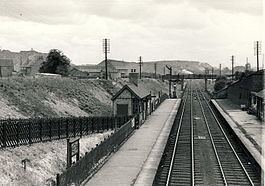Grid reference SK 439 748 Platforms in use 2 | Post-grouping LMSRBritish Railways | |
 | ||
Similar Staveley Central railway st, Barrow Hill railway station, Arkwright Town railway st, Staveley Works railway st, Renishaw Central railway st | ||
Staveley Town is a closed and demolished former railway station in Staveley near Chesterfield, Derbyshire, England.
Contents
Context
The station was on the circuitous Barrow Hill to Elmton and Creswell line via Clowne and Barlborough and the equally circuitous Barrow Hill to Mansfield Woodhouse via Pleasley West line. These routes diverged at Seymour Junction, about half a mile to the east of the station. The line to Pleasley was known as the Doe Lea Branch because it followed the River Doe Lea for several miles. The line to Creswell was known as the Clowne Branch.
History
The station opened without ceremony on 1 November 1888 for services along the Clowne Branch. It was initially called Netherthorpe, being in the Netherthorpe area of Staveley. On 25 October 1893, it became "Netherthorpe for Staveley Town". It was renamed "Staveley Town" on 1 June 1900. Services calling at the station increased with the opening of the Doe Lea Branch on 1 September 1890.
The station was situated in a cutting between the Lowgates overbridge and a footbridge from Fan Road to Netherthorpe, both of which survive. It had two opposing platforms with small buildings on each of which no trace remains. There was a further building at street level which survived for many years after closure, having been bought privately for commercial use.
Normal passenger traffic over the Doe Lea Branch ceased in 1930 and the route was severed by the closure of Rowthorn Tunnel near Hardwick Hall. Coal traffic nevertheless remained the lifeblood of the line. The station closed to passenger traffic on 5 August 1952. In the 1960s pits began to be worked out. Ramcroft Colliery near Glapwell closed in 1966, followed by Glapwell Colliery in 1974 after which the line beyond Bolsover Castle fell into disuse. The line between Bolsover and Glapwell Colliery was taken out of use as from 31 October 1978; it was eventually lifted later in 1978.
Bolsover and Markham Collieries continued to produce coal in large quantities. This was supplemented by traffic to and from the Coalite and Chemical Works at Bolsover. Bolsover Castle station remained open for goods until 1 November 1962 and in usable condition for passenger traffic at least until 1981, which led to some remarkable trains, notably by Miners' Welfare specials to distant points and by specials in connection with the Queen's Jubilee in 1977. These passed through the site of Staveley Town station. The last steam trains to use the line were enthusiasts' specials. On 16 October 1965 a "Last 4F" Midlands Tour ran along the Clowne Branch and to Glapwell then through the site of Staveley Town. On 1 October 1966 an RCTS Notts & Yorks railtour passed through and is believed to have been the very last.
Normal passenger traffic over the Clowne Branch ceased in 1954. Remarkably, the very last train was operated by a brand new Diesel Multiple Unit. Timetabled Summer weekend excursion traffic, notably from Radford to Blackpool continued until 1962, along with football specials. These duly passed through the site of Staveley Town.
Occasional freight and light engine movements over the Clowne Branch continued until the 1990s when an underground fire threatened to undermine the line, compounded by the expensive need to replace the points connecting the branch to what is now known as the Robin Hood Line at Elmton and Creswell. These points were replaced by plain line, as were those at Oxcroft Colliery Junction. The single track between is largely intact, but heavily overgrown.
Bolsover Colliery closed in 1993 and Markham Colliery closed in 1994, followed by Coalite in 2004, which left no traffic on the Doe Lea Branch.
A temporary reprieve for the line through the site of Staveley Town station was obtained following the closure of Arkwright Colliery in 1988. The Arkwright site was eventually opencasted then landscaped, with startling visual impact. The opencasted coal was transported by lorry along the trackbed of the Great Central Main Line north of Arkwright, thence to Oxcroft Disposal Point near Shuttlewood where it was loaded onto Merry-go-Round (MGR) trains which ran through Oxcroft Colliery Junction, Seymour Junction,the station site and Hall Lane Junction to join the ex-MR Chesterfield to Rotherham "Back Line" at Foxlow Junction. This traffic came to a natural end in 2006. On 4 March 2006 the Branch Line Society ran a "last train" special through the station site to the disposal point boundary.
Possible Futures
The line through the station site to Seymour Junction and Oxcroft Disposal Point has been mothballed as there remains the possibility of opencasting in the area. For example, in 2005 UK Coal (now Coalfield Resources), expressed an interest in extracting c530,000 tons near Mastin Moor. The Doe Lea line South to Bolsover (now known as "The Bolsover Branch") has been mothballed as it runs through the new Markham Vale Enterprise Zone at M1 Junction 29A It is hoped that someone will invest in this infrastructure to create road-rail interchange facilities. The branch beyond Bolsover is now a public bridleway known as The Stockley Trail.
